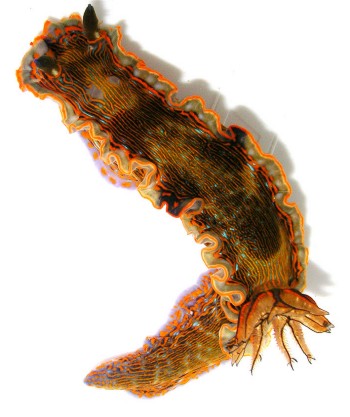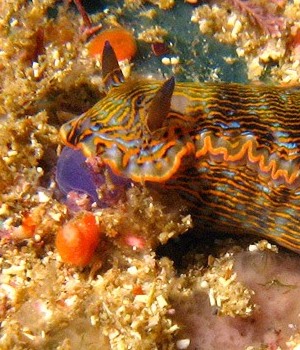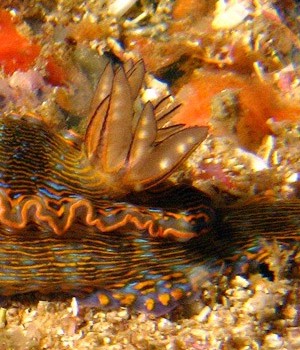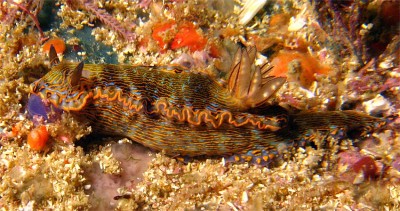Hypselodoris juliae from Brazil [1]
May 31, 2010
From: Vinicius Padula

Dear Bill,
Here are some photos of a new species of Hypselodoris from Brazil - Hypselodoris juliae. The new species is similar to Hypselodoris sp.4, but has a different color pattern (variations of a same species or already isolated biological entities?).
Interesting, Hypselodoris juliae has glands similar to MDF [mantle glands] on the gill tissue. They are not clear in the holotype, but occur in the paratype and are visible on an additional specimen photographed near the type locality ( photo).
Upper Photo: Holotype. MNRJ 10940, 57 mm alive, Praia das Conchas, Cabo Frio, state of Rio de Janeiro, Brazil, intertidal, 14 November 2004. Photo: V. Padula. Lower Photos: Specimen from near type location, close-ups showing everted oral tube, and glands in gills. Photo: Felipe Kuhnert
Best,
Vinicius Padula
viniciuspadula@yahoo.com



Dear Vinicius,
Thanks very much for these photos. I am more confident than you that Hypselodoris sp. 4 is indeed this new species. Even the conspicuous white glands in the gills can be seen in most of the animals I have called Hypselodoris sp. 4, although I mistakenly suggested they were white spots along the edge of the gill in one case. The yellow to orange lines on the mantle, mantle edge and sides of the body, the darker blotches on the mantle, and the dark patch midway down the mantle on each side with orange spots, are all characteristic, even if the shades of yellow and orange vary.
The glands in the gills are very conspicuous. They seem to be present in many chromodorids - and other dorids for that matter - but I don't think anyone has done a review of them across the dorids. From my experience, their presence doesn't seem to be consistent - some animals of a species may have them while others don't. This could mean their presence is cyclic, but unfortunately I don't think we know. If anyone has any relevant references, they would be welcome.
Best wishes,
Bill Rudman
Related messages
-
Hypselodoris juliae from Brazil [2]
From: Peter Wirtz, June 3, 2010 -
Hypselodoris sp. 4 - Post Mating
From: Linda Ianniello, May 16, 2003 -
Hypselodoris sp. 4 eggs
From: Linda Ianniello, September 27, 2002 -
Food of Hypselodoris sp. 4
From: Anne DuPont, October 6, 2001 -
Re: Hypselodoris sp. 4 from Florida
From: Linda Ianniello , October 5, 2001 -
Food of Hypselodoris sp. 4
From: Anne Dupont, September 25, 2001 -
Hypselodoris acriba or H. edenticulata?
From: Anne DuPont, September 25, 2001 -
Hypselodoris acriba or H. edenticulata
From: Anne DuPont, August 21, 2001
